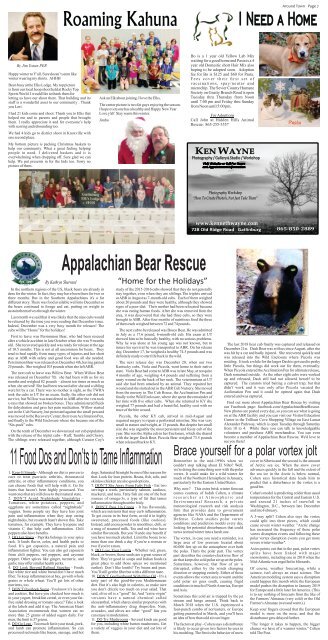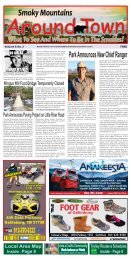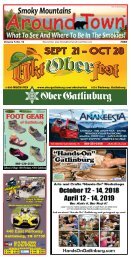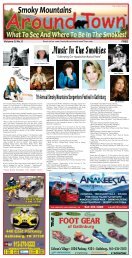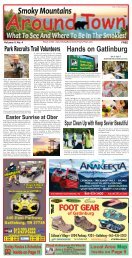Smoky Mountains Around Town / January 2019
What To See And Where To Be In The Smokies!
What To See And Where To Be In The Smokies!
Create successful ePaper yourself
Turn your PDF publications into a flip-book with our unique Google optimized e-Paper software.
<strong>Around</strong> <strong>Town</strong> Page 7<br />
By Jim Yonan PER<br />
Happy winter to Y'all. Sure doesn’t seem like<br />
winter wearing my shorts. AHHH<br />
Been busy at the Elks Lodge. My top picture<br />
is from our local hoop shoot held at Rocky Top<br />
Sports World. I would like to thank them for<br />
letting us have our shoot there. That building and its<br />
staff is a wonderful asset to our community . Thank<br />
you Lori.<br />
I had 21 kids come and shoot. Thank you to Elks that<br />
helped me and to parents and people that brought<br />
them. I really appreciate it and for everyone’s help<br />
with scoring and rebounding too.<br />
We had 4 kids go to district shoot in Knoxville with<br />
one second place.<br />
My bottom picture is packing Christmas baskets to<br />
help our community. What a great feeling helping<br />
people in need. I delivered baskets and it is<br />
overwhelming when dropping off. Sure glad we can<br />
help. We put presents in for the kids too. Sorry no<br />
picture of them.<br />
Ask an Elk about joining. I love the Elks.<br />
The center picture is two fat guys enjoying the season.<br />
I hope everyone has a healthy and Happy New Year<br />
Love y'all Stay warm this winter.<br />
Jimbo<br />
Bo is a 1 year old Yellow Lab Mix<br />
waiting for a good home and Pasta is a 4<br />
year old Domestic short Hair Mix also<br />
hoping to be adopted soon. Adoption<br />
fee for Bo is $125 and $60 for Pasta.<br />
F e e s c o v e r t h e i r fi r s t s e t o f<br />
vaccinations, spay/neuter and<br />
microchip. The Sevier County Humane<br />
Society on Gnatty Branch Road is open<br />
Tuesday thru Thursday from Noon<br />
until 7:00 pm and Friday thru Sunday<br />
from Noon until 5:00 pm.<br />
For Adoptions<br />
Call John at Hidden Hills Animal<br />
Rescue: 865-255-3557<br />
KEN WAYNE<br />
Photography / Gallery & Studio / Workshop<br />
Appalachian Bear Rescue<br />
By Kathryn Sherrard<br />
In the northern regions of the US, black bears are already in<br />
dens for the winter. In fact, they may have been there for two or<br />
three months. But in the Southern Appalachians it's a far<br />
different story. There was food available well into December so<br />
the bears continued to forage and eat, putting on weight to<br />
sustain themselves through the winter.<br />
Last month we said that it was likely that the nine cubs would<br />
be released by the time you were reading that December issue.<br />
Indeed, December was a very busy month for releases! The<br />
cubs will be “Home” for the holidays!<br />
First to leave was Persimmon Bear, who had been rescued<br />
after a vehicle accident in late October when she was 9 months<br />
old. She recovered quickly and was ready for release at the age<br />
of 10.5 months. This is not at all uncommon for bears. They<br />
tend to heal rapidly from many types of injuries and her short<br />
stay at ABR with safety and good food was all she needed.<br />
Persimmon Bear was released on December 4th, having gained<br />
25 pounds. She weighed 103 pounds when she left ABR.<br />
The next cub to leave was Willow Bear. When Willow Bear<br />
was released on December 7th she had been with us for six<br />
months and weighed 82 pounds – almost ten times as much as<br />
when she arrived! She had been rescued after she and a sibling<br />
were hit by a car. There was no mother is sight, so the TWRA<br />
took the cubs to UT for an exam. Sadly, the other cub did not<br />
survive, but Willow was transferred to ABR after the vets took<br />
x-rays that showed no broken bones. They administered fluids<br />
for dehydration and gave her pain medication. Willow started<br />
out in the Cub Nursery, but protested against the small pen and<br />
was moved to the Recovery Center, then to an Acclimation Pen,<br />
and finally to the Wild Enclosure where she became one of the<br />
“Six-pack” cubs.<br />
On the tenth of December we downsized our cub population<br />
with the release of the triplet cubs – Ruff, Tumble and Cherry.<br />
The siblings were released together, although Curator Coy's<br />
study of the 2015-2016 cubs showed that they do not generally<br />
stay together, even when they are siblings.The triplets arrived<br />
at ABR in August as 7-month-old cubs. Each of them weighed<br />
about 20 pounds and they were healthy, although they showed<br />
signs of a poor diet. Their mother had been relocated because<br />
she was eating human foods. After she was removed from the<br />
area, it was discovered that she had three cubs, so they were<br />
brought to ABR. After four months of nutritious food the three<br />
of them each weighed between 72 and 74 pounds.<br />
The next cub to be released was Bosco Bear. He was admitted<br />
in July as a 17.6 pound, 6-month-old cub. His exam at UT<br />
showed him to be basically healthy, with no serious problems.<br />
Why he was alone at his young age was not known, but to<br />
insure his survival he was transported to ABR. On his release<br />
day, December 17, he weighed a healthy 74.5 pounds and was<br />
definitely ready to start life back in the wild.<br />
The next release day was December 20, when our two<br />
Kentucky cubs, Viola and Piccola, went home to their native<br />
state. Viola Bear had come to ABR was in late May, at not quite<br />
4 months of age, weighing 4.4 pounds and suffering from a<br />
nasty wound on the back of her neck. The veterinarians at UT<br />
said she had been attacked by an animal. They repaired her<br />
wound and she started out in the ABR Cub Nursery. She moved<br />
from the nursery to The Cub House, the Acclimation Pen and<br />
finally to the Wild Enclosure, where she spent the remainder of<br />
her time with five other cubs. When she returned to KY she<br />
weighed 77 pounds and had a beautiful, healthy coat with no<br />
trace of the bite wound.<br />
Piccola, the other KY cub, arrived in mid-August and<br />
required surgery to repair a perforated intestine. She was very<br />
small in stature and weight, at 13 pounds. But despite her small<br />
size she was arguably the most persistent and feisty cub of the<br />
year. She was the Alpha cub in her Enclosure, which she shared<br />
with the larger Dash Bear. Piccola Bear weighed 73.5 pounds<br />
when released back to KY.<br />
The last 2018 bear cub finally was captured and released on<br />
December 21st. Dash Bear was with us since August, after she<br />
was hit by a car and badly injured. She recovered quickly and<br />
was released into the Wild Enclosure where Piccola was<br />
residing. It took a while for the larger Dash to get used to pesky<br />
little Piccola, but things did work out for them, eventually.<br />
When Piccola entered the Acclimation Pen for ultimate release,<br />
Dash remained outside. As the other eight cubs were worked<br />
up and released, Dash still had not allowed herself to be<br />
captured. The curators tried baiting a culvert trap, but that<br />
didn't work and it was only after Piccola vacated the<br />
Acclimation Pen and it could be opened again that Dash<br />
entered and was captured.<br />
Find out more about Appalachian Bear Rescue by visiting<br />
our Facebook page: facebook.com/AppalachianBearRescue.<br />
New photos are posted every day, so you can see what is going<br />
on at the ABR facility and you can visit our Visitor/Education<br />
Center in the Trillium Cove Shopping Village on East Lamar<br />
Alexander Parkway, which is open Tuesday through Saturday<br />
from 10 to 4. While there you can talk to knowledgeable<br />
volunteers and purchase ABR merchandise. You can even<br />
become a member of Appalachian Bear Rescue. We'd love to<br />
see you there!<br />
11 Food Dos and Don’ts to Tame Inflammation<br />
Remember<br />
1. Keep It Simple - Although no diet is proven to<br />
cure or treat psoriatic arthritis, rheumatoid<br />
arthritis, or other inflammatory conditions, you<br />
can choose foods that will help with it. Go for<br />
items that haven’t been highly processed. You<br />
want ones that are still close to their natural state.<br />
2. DON’T Avoid Nightshade Vegetables -<br />
Tomatoes, white potatoes, peppers, and<br />
eggplants are sometimes called “nightshade”<br />
veggies. Some people say they have less joint<br />
pain and inflammation when they stop eating<br />
nightshades, but research hasn't shown this. Take<br />
tomatoes, for example. They have lycopene and<br />
vitamin C that help curb inflammation. Chili<br />
peppers also have benefits.<br />
3. DO Get Spicy - Paprika belongs in your spice<br />
rack. It lends flavor, color, and health perks to<br />
food. It’s got capsaicin, a natural pain and<br />
inflammation fighter. You can also get capsaicin<br />
from chili peppers, red peppers, and cayenne<br />
pepper. Other spices like ginger, turmeric, and<br />
garlic may offer similar health perks.<br />
4. DO Look Beyond Refined Starches - Foods<br />
like white rice and white bread don’t have much<br />
fiber. To keep inflammation at bay, go with whole<br />
grains or whole wheat. You’ll get lots of other<br />
nutrients, too.<br />
5. DON’T Overlook Sugar - You know it’s in cake<br />
and cookies. But have you checked how much is<br />
in your yogurt, breakfast cereal, or even your fatfree<br />
salad dressing or tomato sauce? Take a look<br />
at the labels and add it up. The American Heart<br />
Association recommends that women eat no<br />
more than 25 grams of added sugars daily. For<br />
men, the limit is 37 grams.<br />
6. DO Go Lean - Too much fat in your steak, pork,<br />
and lamb can promote inflammation. So can<br />
processed red meats like bacon, sausage, and hot<br />
dogs. Saturated fat might be one of the reasons for<br />
that. Look for lean protein. Beans, fish, tofu, and<br />
skinless chicken are also good options.<br />
7. DON’T Shy Away From Fatty Fish - Eat two<br />
servings a week, particularly salmon, sardines,<br />
mackerel, and tuna. Fatty fish are one of the best<br />
sources of omega-3s, a type of fat that tames<br />
inflammation throughout the body.<br />
8. DON’T Pass Up Cocoa - It has flavonoids,<br />
which are nutrients that may curb inflammation.<br />
To get cocoa in its best form, avoid it in highly<br />
sweetened, processed foods (like cookies).<br />
Instead, add cocoa powder to smoothies, chili, or<br />
a mug of steamed milk. Tea and red wine have<br />
similar flavonoids. But you’ll undo any benefit if<br />
you have too much alcohol. Limit the booze to no<br />
more than one drink a day if you're a woman or<br />
two if you're a man.<br />
9. DO Love Your Lentils - Whether red, green,<br />
black, or brown, these seeds are a great source of<br />
fiber. They’re good in soups and Indian foods (a<br />
great place to add those spices we mentioned<br />
earlier). Don’t like lentils? Try beans and peas.<br />
You’ll still get the fiber but with a different taste.<br />
10. DON’T Go Overboard With Olive Oil - It's a<br />
tasty part of the good-for-you Mediterranean<br />
diet. But it’s also high in calories, so make sure<br />
you don’t drizzle too much on your salad. That<br />
said, olive oil is a “good” fat. And “extra virgin”<br />
versions have a natural chemical called<br />
oleocanthal, which shares similar properties with<br />
the anti-inflammatory drug ibuprofen. Nuts,<br />
avocados, and olives are other “good” fats you<br />
can enjoy in moderation.<br />
11. DO Try Mushrooms - Several kinds are good<br />
for you, including white button mushrooms. Get<br />
a variety of veggies in your diet and eat lots of<br />
them.<br />
in the mid-1990s when we<br />
couldn't stop talking about El Niño? Well,<br />
we're doing the same thing now with the polar<br />
vortex. It could make for a wild winter for<br />
much of the Northern Hemisphere in <strong>January</strong>,<br />
particularly for the Eastern United States.<br />
Why now? This extra brisk winter forecast<br />
comes courtesy of Judah Cohen, a climate<br />
r e s e a r c h e r a t A t m o s p h e r i c a n d<br />
Environmental Research, a private<br />
meteorological research and risk analysis<br />
firm that provides data to government<br />
agencies like NASA and the Department of<br />
Defense. Cohen studies polar vortex<br />
conditions and prediction models every day,<br />
looking for potential disturbances that could<br />
turn a normal winter into a harsh one.<br />
The vortex, in case you need a reminder, is a<br />
large area of low pressure located about<br />
60,000 feet up on the atmosphere over both<br />
the poles. That's the polar part. The vortex<br />
part describes the counter-clockwise flow of<br />
air that keeps the cold polar air up at the poles.<br />
Sometimes, however, that flow of air is<br />
disrupted, either by the winds changing<br />
direction or stopping entirely. Either of these<br />
events allows the vortex area to warm and the<br />
cold polar air goes south, causing frigid<br />
conditions in much of North America, Europe<br />
and Asia.<br />
Sometimes this cold air is trapped by the jet<br />
stream and hangs around. Think back to<br />
March 2018 when the U.S. experienced a<br />
four-punch combo of nor'easters, or Europe<br />
getting pummeled in March, and you'll have<br />
an idea of how that cold air can linger.<br />
The factors at play - Cohen says a disturbance<br />
is likely to occur given two factors he uses in<br />
his modeling. The first is the behavior of snow<br />
cover in Siberia and the second is the amount<br />
of Arctic sea ice. When the snow cover<br />
advances quickly in the fall and the extent of<br />
the sea ice in the Arctic is below normal,<br />
Cohen says historical data leads him to<br />
predict that a disturbance in the vortex is a<br />
good bet.<br />
Cohen's model is predicting colder than usual<br />
temperatures for the Central and Eastern U.S.<br />
and around 21 inches of snowfall in<br />
Washington, D.C., between late December<br />
and into February.<br />
A 3-way split? Cohen also says the vortex<br />
could split into three pieces, which could<br />
cause severe winter weather. "Arctic change<br />
has increased the frequency of these polar<br />
vortex disruption events and following these<br />
polar vortex disruption events you get more<br />
severe winter weather".<br />
Axios points out that in the past, polar vortex<br />
splits have been linked with major<br />
snowstorms, including one in 2010 when the<br />
Mid-Atlantic was engulfed in blizzards.<br />
Of course, weather forecasting, while a<br />
science, isn't always an exact science. The<br />
American modeling system says a disruption<br />
could happen this month while the European<br />
model pushes the disruption to <strong>January</strong> <strong>2019</strong><br />
for Europe and a little later for America. (This<br />
is to say nothing of forecasts from the like of<br />
the Farmers' Almanac (very cold) or the Old<br />
Farmer's Almanac (wet and warm).)<br />
Keep your fingers crossed that the European<br />
model is more on the nose, and that the<br />
disturbance gets delayed further.<br />
"The longer it takes to happen, the bigger<br />
chance we have of a warmer winter," Cohen<br />
told The Post.


